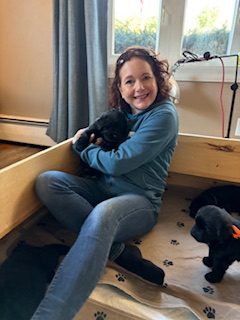We said we would not do it again. We were going to be a one dog family. And the dog would be small, easily transportable. That’s when we got Rufus Rapscallion the Shih Tzu. We had never had owned a small dog before and raising Rufus, who is now 2 ½, was challenging. Everything was different – the potty training, the barking, the pee pads, the side-eye. He was our 8th dog and at times it felt as if we had never raised one before.
We love Rufus, of course we do, but we both started to miss that big dog energy, and sweetness, and, okay, lack of barking. We thought Murphy was going to be our last large dog and certainly our last Newfoundland, but – oops we did it again.
We contacted Murphy’s breeder, who was retired but told us her two daughters were breeding on a more limited basis. One of the sisters was not able to breed her female when she was in heat due to the dog’s illness. The other sister was expecting a litter in September. We had a lot to decide.
We could not face bringing home a dog who looked just like Murphy. Newfoundlands come in 3 colors, the most common, black (like Murphy), plus brown and Landseer, which is a black and white mixture. The name Landseer comes from the English painter, Edward Landseer who painted a lot of these black and white dogs. In England the Landseer is a separate breed from the Newfoundland and looks a bit different, more slender, smaller head. But in the U.S. the Landseers are bred back into black so maintain the classic Newfoundland appearance and temperament.
We wanted a Landseer, preferably a female which we thought would be better for Rufus. Now here is where I took a deep dive into canine genetics. The Landseer coloring is a recessive trait, similar to blue eyes in humans. Both of the parents were black but had a recessive Landseer gene. Since we were familiar with the dogs of this particular breeding family, we were pleased to know that the father was Murphy’s half-brother. Then doing the math and looking at the pedigree, we saw that he was Murphy’s older brother. Murphy died almost two years ago at age 12 and ½. Upon further digging we learned the father was dead and the sisters had a goodly supply of frozen sperm, OK, brave new world. Some of the other breeders I’ve talked with had not had much success with frozen sperm.
Our breeder had the procedure was done at a vet’s office, similar to IVF. The puppies of last year’s litter, done this way, were healthy and thriving. So we were ok with this. Also upon examining the pedigree, we found that the mother was a daughter of Troy. It sounds like a secret society but in fact, is just literal. We met Troy when we first visited Murphy’s litter and he was the largest, Newfoundland we’d ever seen. So gulp, this puppy was likely to be bigger than Murphy, who never got beyond 115 pounds, small for a Newf.



We were on tenderhooks waiting for the litter to be born. We found out, since there were 10 puppies, a c-section was planned. Two did not survive, but of the 8, there were two Landseers, both male. So we had a decision to make. Should we wait for a prospective litter the other sister was planning, or should we go for the male, which would have been our preference if we were not considering Rufus? We decided to keep an open mind and first see the litter of eight, five-week old puppies.
I asked the breeder to give us her impressions of the pups. Of the Landseer boys, one was smaller and she described him as feisty. He had a completely black head which would have made him look a lot like Murphy. The black female, Miss Pink, was adorable and the breeder loved her temperament and her head. But she would have looked exactly like Murphy. We puppy-tested Miss Pink and the Landseer boy, whom they were calling Big Larry.. Both passed easily but the Landseer boy appeared a little more confident. Plus I loved his markings and I was already in love with him. So it was decided.
To be continued…
You must log in to post a comment.